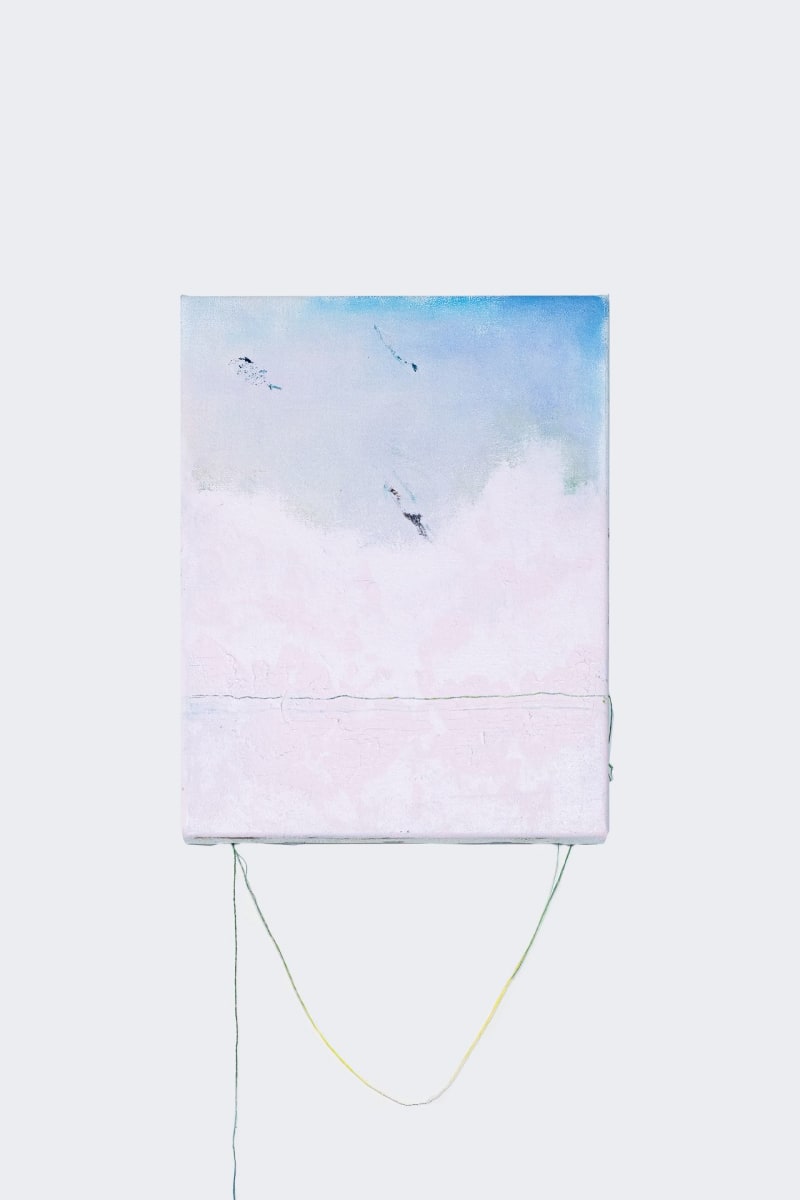25 october 2024, Yves Joris
Jonas Callaert, an escape from the landscape
It isn’t often that a painting forces you to look differently, not only at the canvas itself, but also at the space around it. In It all started with Dirty Dancing at Galerie De Wael 15, Jonas Callaert invites the viewer to pause and reflect on painting as a medium, with the landscape as a starting point. This exhibition not only pushes the boundaries of figuration and abstraction, but also plays a masterful game with the physical presence of the paintings. Callaert, who studied at the Sint-Lucas School of Arts in Ghent, is not a traditional landscape painter; his work does not depict specific locations, but is a conceptual exploration of colour, form and the art of painting itself.

Jonas Callaert, It turns out everything falls into place 2, 2024, Art Gallery De Wael 15
In his work, Callaert often begins with photographs of landscapes, but these images serve merely as a springboard to a more universal theme. The recognisable shapes of nature quickly disappear in his process, making way for collages in which the original locations dissolve into an abstract representation. It is in colour that he seeks the essence of the landscape: the blue of the sky, the green of grass. These colours serve as the guiding principle for his paintings, but what remains is not a faithful representation of a specific place; Callaert's work blurs the boundaries between abstraction and figuration, with the horizon often disappearing or serving only as a subtle reference. The landscape is both present and absent.
What makes Callaert's work so intriguing is how he explores the material properties of painting. His paintings are not flat surfaces, but objects that occupy space. The edges of the canvas and thickness of the stretcher frame are elements that are not concealed but emphasised. In some work, the canvas appears to be separating from the frame, as if the painting itself were trying to escape the limitations of its two-dimensional form. This creates a fascinating tension between the painting as an image and the painting as an object, challenging the viewer to look not only at what is painted on the canvas, but also at how it is made.

Jonas Callaert, I have sprayed you into my eyes, 2024, Art Gallery De Wael 15
Window or object?
A central theme in Callaert's work is the notion of the painting as a window to the world, a concept that dates back to the Renaissance. But whereas traditional landscape painters used the window to capture reality, Callaert turns this idea upside down. He sees the painting not only as an illusion, but also as a tangible object existing in space. This physical approach to painting positions his work in dialogue with the viewer, who is invited to view the paintings not only as images, but also as material constructions. The paint remains paint, the brushstrokes remain visible and the viewer can almost touch the layers of the painting process.
In some work, Callaert adds rope and thread, referring to the horizon while separating the painting from its traditional two-dimensional context. This once again emphasises the duality in his work: it is both an image and an object. The viewer is invited to explore the dialogue between these two dimensions. Callaert challenges the conventions of landscape painting, opening up new perspectives on what a painting can be.
What makes this exhibition particularly interesting is Callaert's use of titles, which often refer to personal or cultural references, such as the work Little bastard (the death of James Dean), a playful reference to James Dean's car. This adds a light-hearted element to the abstract visual language of his work and invites the viewer to look beyond the painting itself. It raises questions about the relationship between image and meaning, between what is visible and what remains hidden.

Jonas Callaert, Little bastard (the death of James Dean), 2024, Art Gallery De Wael 15
In It all started with Dirty Dancing, Jonas Callaert shows how painting can reinvent itself. He pushes the boundaries of landscape painting by undermining traditional notions of representation. Instead of offering a window onto the world, his paintings are autonomous objects that occupy their own space and engage in dialogue with their surroundings.
Callaert's work offers a refreshing take on the landscape, not as a depiction of a specific place, but as a conceptual exploration of colour, form and texture. His paintings force us to look differently, not only at nature, but also at painting itself. This exhibition offers a unique opportunity to explore the boundaries of the medium and reconsider the role of the viewer. After all, in the world of Jonas Callaert, nothing is as it seems – and that makes his work all the more fascinating.

Jonas Callaert, I like to go home without telling, 2024, Art Gallery De Wael 15
